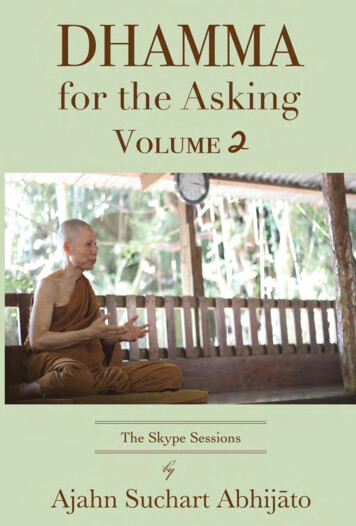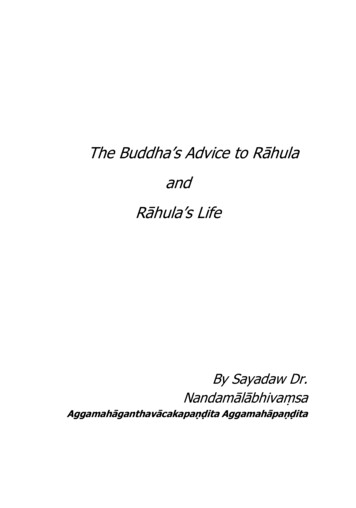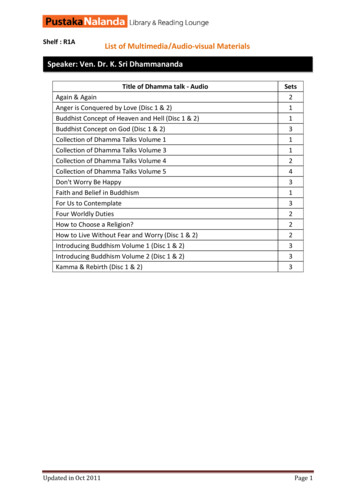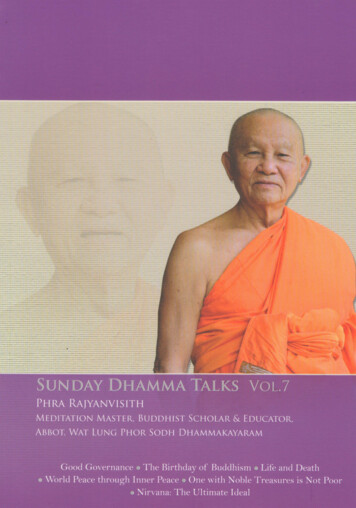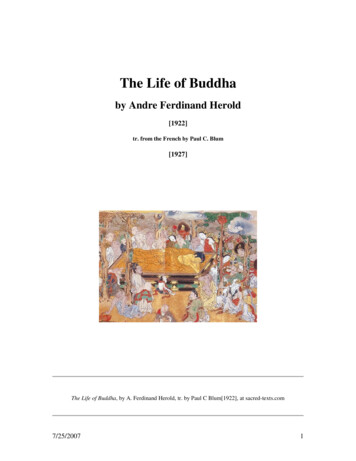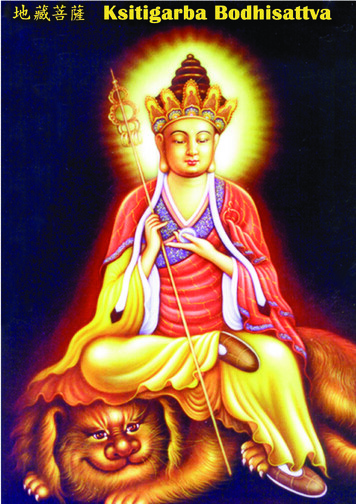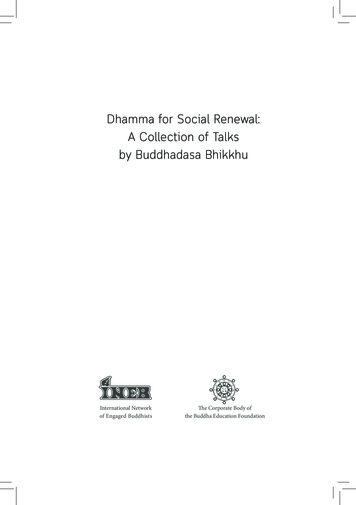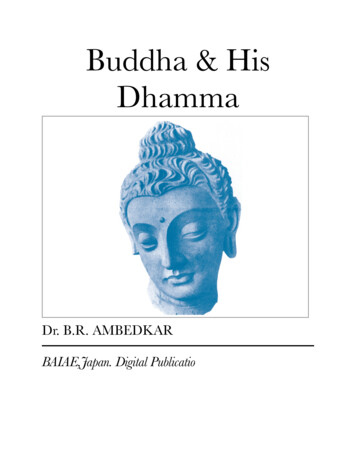
Transcription
Buddha & HisDhammaDr. B.R. AMBEDKARBAIAE,Japan. Digital Publicatio
INTRODUCTION .18PROLOGUE .20BOOK I: SIDDHARTH GAUTAMA—HOW ABODHISATTA BECAME THE BUDDHA?.21Part I: From Birth to Parivraja. .22§ 1. His Kula .22§ 2. His Ancestry .22§ 3. His Birth .23§ 4. Visit by Asita .24§ 5. Death of Mahamaya .26§ 6. Childhood and Education .27§ 7. Early Traits .27§ 8. Marriage .29§ 9. Father's Plans to Save His Son .30§ 10. The Failure of the Women to Win the Prince .31§ 11. The Prime Minister's Admonition to the Prince .32§ 12. The Prince's Reply to the Prime Minister .33§ 13. Initiation into the Sakya Sangh .34§ 14. Conflict with the Sangh .35§ 15. Offer of Exile .36§ 16. Parivraja--the Way Out .38§ 17. Parting Words .38§ 18. Leaving His Home .40§ 19. The Prince and the Servant .42
§20. The Return of Channa .44§21 The Family in Mourning .44Part II: Renunciation for Ever .46§ 1. From Kapilavatsu to Rajagraha .46§ 2. King Bimbisara and his Advice .46§ 3. Gautama Answers Bimbisara .48§ 4. Reply by Gautama (concluded) .51§ 5. News of Peace .52§ 6. The Problem in a New Perspective .53Part III: In Search of New Light .54§ 1. Halt at Brighu's Ashram .54§ 2. Study of Sankhya .55§ 3. Training in Samadhi Marga .55§ 4. Trial of Asceticism .56§ 5. Abandonment of Asceticism .58Part IV: Enlightenment and the Vision of a New Way.59§ 1. Meditation for New Light .59§2. Enlightenment .60§ 3. The Discovery of a New Dhamma .60§ 4. Gautama who was a Bodhisatta, After Sammabodhi Becomes a Buddha .61Part V: The Buddha and His Predecessors .63§1. The Buddha and the Vedic Rishis .63§2. Kapila— The Philosopher .64§ 3. The Bramhanas .66§4. The Upanishads and Their Teachings .69
Part VI: The Buddha and His Contemporaries .71§ 1. His Contemporaries .71§ 2. His Attitude to His Contemporaries .72Part VII: Comparison and Contrast .73§ 1. What HE Rejected .73§ 2. What HE Modified.73§3. What HE Accepted .74BOOK II: CAMPAIGN OF CONVERSION .1Part I: Buddha and His Vishad Yoga .2§1. To Preach or Not to Preach .2§ 2. Proclamation of Good News by Brahma Sahampati .3§ 3. Two Types of Conversion .3Part II: The Conversion of the Parivrajakas .5§ 1. Arrival at Sarnath .5§ 2. The Buddha's First Sermon .5§ 3. The Buddha's First Sermon—(contd.) The Path of Purity .7§ 4. The Buddha's First Sermon (cont'd)—Ashtanga Marga or the Path of Righteousness .7§ 5. The Buddha's First Sermon (cont'd)—The Path of Virtue .10§ 6. The Buddha's First Sermon (concluded) .10§ 7. The Response of the Parivrajakas .12Part III: Conversion of the High and the Holy .13§1. Conversion of Yashas .13§ 2. Conversion of the Kassyapas .14§ 3. Conversion of Sariputta and Moggallana .16
§ 4. Conversion of King Bimbisara .18§ 5. Conversion of Anathapindika .19§ 6. Conversion of King Pasenjit .21§ 7. Conversion of Jeevaka .22§ 8. The Conversion of Ratthapala .23Part IV: Call from Home .27§ 1. Suddhodana and the Last Look .27§ 2. Meeting Yeshodhara and Rahula .28§ 3. Reception by the Sakyas .30§ 4. Last attempt to make Him a Householder .31§ 5. The Buddha's Answer.32§6. The Minister's Reply .33§7. The Buddha's Determination .34Part V: Campaign for Conversion Resumed.36§ 1. Conversion of Rustic Brahmins .36§ 2. Conversion of the Brahmins of Uttaravati .37Part VI: Conversion of the Low and the Lowly.39§ 1. Conversion of Upali, the Barber .39§ 2. Conversion of Sunita, the Sweeper .39§ 3. Conversion of Sopaka and Suppiya, the Untouchables .40§ 4. Conversion of Sumangala and other Low Castes .40§5. Conversion of Supprabuddha, the Leper .41Part VII: Conversion of Women.43§1 Conversion of Mahaprajapati Gautami, Yeshodhara, and her Companions .43§ 2. Conversion of Prakrati, a Chandalika .45
Part VIII: Conversion of the Fallen and the Criminals .47§ 1 Conversion of a Vagabond .47§ 2 Conversion of Angulimala, the Robber .47§ 3. Conversion of Other Criminals .49§ 4. Risk of Conversion .50BOOK III: WHAT THE BUDDHA TAUGHT .1Part I: His Place in His Dhamma .2§ 1. The Buddha claimed no place for Himself in His own Dhamma .2§ 2. The Buddha did not promise to give Salvation. He said He was Marga Data (Way Finder) and notMoksha Data (Giver of Salvation) .3§ 3. The Buddha did not Claim any Divinity for himself or for his Dhamma. It was discovered by manfor man. It was not a Revelation.5Part II: Different Views of the Buddha's Dhamma .7§ 1. What others have understood Him to have Taught .7§ 2. The Buddha's Own Classification .7Part III: What is Dhamma .9§ 1. To Maintain Purity of Life is Dhamma .9§ 2. To Reach Perfection in Life is Dhamma.11§ 3. To Live in Nibbana is Dhamma .11§ 4. To Give up Craving is Dhamma .14§ 5. To believe that all compound things are impermanent is Dhamma .15§ 6. To believe that Karma is the instrument of Moral Order is Dhamma.16Part IV: What is not Dhamma .19§ 1. Belief in the Supernatural is Not Dhamma.19§ 2. Belief in Ishwara (God) is Not Essentially Part of Dhamma .19
§ 3. Dhamma Based on Union with Brahma is a False Dhamma .22§ 4. Belief in Soul is Not Dhamma .24§ 5. Belief in Sacrifices is Not Dhamma .27§ 6. Belief Based on Speculation is Not Dhamma .30§ 7. Reading Books of Dhamma is Not Dhamma .32§ 8. Belief in the infallibility of Books of Dhamma is Not Dhamma .33Part V: What is Saddhamma .36SECTION ONE--THE FUNCTIONS OF SADDHAMMA .36§ 1. To Cleanse the Mind of its Impuritiesे .36§ 2. To Make the World a Kingdom of Righteousness .37SECTION TWO--DHAMMA TO BE SADDHAMMA MUST PROMOTE PRADNYA .39§ 1. Dhamma is Saddhamma when it Makes Learning Open to All .39§2. Dhamma is Saddhamma when it Teaches that Mere Learning is Not Enough: itmay Lead to Pedantry .41§3. Dhamma is Saddhamma when it Teaches that what is Needed is Pradnya.41SECTION THREE--DHAMMA TO BE SADDHAMMA MUST PROMOTE MAITRI .43§ 1. Dhamma is Saddhamma only when it Teaches that Mere Pradnya is Not Enough:it must be accompanied by Sila.43§ 2. Dhamma is Saddhamma only when it Teaches that besides Pradnya and Silawhat is Necessary is Karuna .44§ 3. Dhamma is Saddhamma only when it Teaches that More than Karuna what isNecessary is Maitri .44SECTION FOUR--DHAMMA TO BE SADDHAMMA MUST PULL DOWN ALL SOCIALBARRIERS .46§ 1. Dhamma to be Saddhamma must break down barriers between Man and Man 46§ 2. Dhamma to be Saddhamma must Teach that Worth and not Birth is the Measureof Man .49
§ 3. Dhamma to be Saddhamma must Promote Equality between Man and Man.50BOOK IV: RELIGION AND DHAMMA .1Part I: Religion and Dhamma .2§ 1. What is Religion? .2§2. How Dhamma Differs From Religion .2§ 3. The Purpose of Religion and the Purpose of Dhamma .3§ 3 part 2 -- The other differences between Religion and Dhamma are brought out in the discussionbetween the Blessed One and Potthapada. .5§ 4. Morality and Religion .6§ 5. Dhamma and Morality .6§ 6. Mere Morality is not Enough: it must be Sacred and Universal .7Part 2: How Similarities in Terminology Conceal Fundamental Difference.9SECTION ONE--REBIRTH .9§ 1. Preliminary .9§ 2. Rebirth of What?.9§3. Rebirth of Whom? .11SECTION TWO--KARMA .13§ 1. Is the Buddhist Doctrine of Karma the same as the Brahminic Doctrine? .13§ 2. Did the Buddha believe in Past Karma having effect on Future Life? .14§ 3. Did the Buddha believe in Past Karma having effect on Future Life? —concluded.16SECTION THREE--AHIMSA .18§ 1. The different ways in which it was interpreted and followed .18§ 2. True Meaning of Ahimsa .18SECTION FOUR--TRANSMIGRATION .19
§ 1. Migration of soul from one body to another (Transmigration) .19§ 2. Causes of Misunderstandng .20Part III: The Buddhist Way of Life .22§ 1. On Good, Evil, and Sin .22§ 2. On Craving and Lust .23§ 3. On Hurt and Ill-will .24§4. On Anger and Enmity .24§ 5. On Man, Mind, and Impurities .25§ 6. On Self and Self-Conquest .26§ 7. On Wisdom, Justice, and Good Company .27§ 8. On Thoughtfulness and Mindfulness .29§9. On Vigilance, Earnestness, and Boldness .29§ 10. On Sorrow and Happiness; On Charity and Kindness .30§ 11. On Hypocrisy .31§ 12. On Following the Right Way .31§ 13. Mix not True Dhamma with False Dhamma .32Part IV: His Sermons .33SECTION ONE--SERMONS FOR HOUSEHOLDERS .33§ 1. The Happy Householder.33§ 2. [A] Daughter may be better than a Son.33§ 3. Husband and Wife.34SECTION TWO--SERMONS ON THE NEED FOR MAINTAINING CHARACTER .34§ 1. What Constitutes the Downfall of Man .34§2. The Wicked Man.35§ 3. The Best Man .36
§ 4. The Enlightened Man .36§5. Man—Just and Good .37§ 6. Need for Doing Good Deeds .38§ 7. Need for Making Good Resolutions .38SECTION THREE--SERMONS ON RIGHTEOUSNESS .38§1 What is Righteousness .39§2. Need for Righteousness .40§ 3. Righteousness and the Claims of the World .41§ 4. How to Reach Perfection in Righteous Conduct .42§ 5. One Need Not Wait for a Companion to Tread on the Path of Righteousness .43SECTION FOUR--SERMONS ON NIBBANA .44§ 1. What is Nibbana? .44§ 2. The Roots of Nibbana .44SECTION FIVE--SERMONS ON DHAMMA .46§ 1. Why Right Views Rank First .46§ 2. Why Bother About Life After Death? .46§ 3. Prayers and Invocations to God are a Futility .46§ 4. It is Not What You Eat that Makes You Holy .47§ 5. Not Food But Evil Actions That Matter .48§ 6. Not Enough Is Outward Washing .49§7. What is Holy Life? .49SECTION SIX--SERMONS ON SOCIO-POLITICAL QUESTIONS .50§ 1. Do Not Depend on the Favour of Princes .50§2. If the King is Righteous, his Subjects will be Righteous .50§3. It is the Social System on which Depends Political and Military Strength.51
§ 4. War is Wrong .52§ 5. The Duty of the Victor Who Has Won Peace .53BOOK V: THE SANGH .1Part I: The Sangh.2§ 1. The Sangh and its Organisation .2§2. Admission to the Sangh .2§ 3. The Bhikkhu and His Vows .3§ 4. The Bhikkhu and Ecclesiastical Offences .4§ 5. The Bhikkhu and Restraints .4§ 6. The Bhikkhu and Good Conduct Rules .4§ 7. The Bhikkhu and the Trial of Offences .5§ 8. The Bhikkhu and Confession.5Part II: भ The Bhikkhu: the Buddha's Conception of Him .7§ 1. Buddha's Conception of What a Bhikkhu Should Be.7§ 2. The Bhikkhu and the Ascetic .8§3. The Bhikkhu and the Brahmin .11§ 4. The Bhikkhu and the Upasaka .11Part III: The Duties of the Bhikkhu .131. The Bhikkhu's Duty to Convert .13§2. Conversion Not to be by Miracles .14§ 3. Conversion Not to be by Force .15§ 4. A Bhikkhu Must Fight to Spread Virtue (Dhamma) .18Part IV: The Bhikkhu and the Laity .19§ 1. The Bond of Alms .19
§ 2. Mutual Influence .19§ 3. Dhamma of the Bhikkhu and the Dhamma of the Upasaka .19Part V: Vinaya for the Laity .22§ 1. Vinaya for the Wealthy .22§ 2. Vinaya for the Householder .23§ 3. Vinaya for Children .
BOOK III: WHAT THE BUDDHA TAUGHT.1 Part I: His Place in His Dhamma.2 § 1. The Buddha claimed no place for Himself in His own Dhamma.2 § 2. The Buddha did not promise to giv
